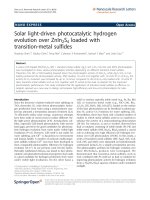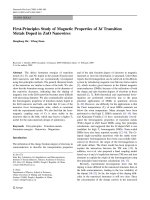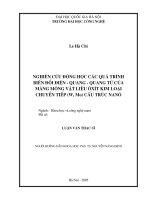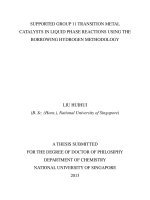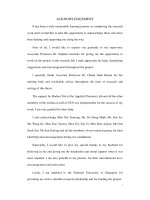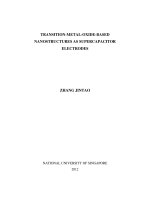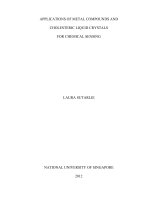4d transition metal doped lini0 5mn1 5o4 cathodes for high power lithium batteries
Bạn đang xem bản rút gọn của tài liệu. Xem và tải ngay bản đầy đủ của tài liệu tại đây (6.09 MB, 170 trang )
4d Transition Metal Doped LiNi0.5Mn1.5O4 Cathodes for
High Power Lithium Batteries
WANG HAILONG
(B.Sc., M.Sc.)
A THESIS SUBMITTED
FOR THE DEGREE OF DOCTOR OF PHILOSOPHY
DEPARTMENT OF MECHANICAL ENGINEERING
NATIONAL UNIVERSITY OF SINGAPORE
2011
Acknowledgements
I would like to express my deepest and heartfelt gratitude and appreciation to my
supervisors, Professor Lu Li and Associate Professor Lai Man On, for their valuable
guidance, continuous support and encouragement throughout the entire research work.
Their wise counsel, unique insights and perspectives and noteworthy talents and
dedication, accompanied me throughout the research project.
I would like to thank Dr. Yang Ping and Dr. Zhang Jixuan for their precious
advices on crystallography and TEM operation. In addition, I want to express my
appreciations to Dr. Xiao Wei and Xia Hui for the many valuable discussions. During
the four years of research work, numerous encouraging supports and help were
delivered by my friends. I would like to acknowledge them: Dr. Zhang Zhen, Wang
Zhiyu, Mr. Ye Shukai, Xiao Pengfei, Song Bohang, Lin Chunfu and Ms Zhu Jing. I
would also like to acknowledge the following staff member in the Materials Lab for
their help, without which this project would not be successfully completed: Mr.
Thomas Tan, Abdul Khalim, Ng Hong Wei and Dr. Maung Aye Thein. Their
professional work provides a good working environment for this research project.
A special appreciation goes to my wife He Miao, her endless support and
understanding help me complete this work successfully.
I
Table of contents
Table of Contents
Summary ...................................................................................................................V
List of Figures ........................................................................................................ VII
List of Tables........................................................................................................... XI
List of Symbols ...................................................................................................... XII
Chapter 1 . Background, Motivation and Orientation............................................... 1
1.1 Introduction to Rechargeable Lithium Batteries .......................................... 1
1.2 Literature review .......................................................................................... 5
1.2.1 Cathode materials with Layered structure ......................................... 5
1.2.2 Cathode materials with Spinel structure .......................................... 14
1.2.3 Cathode materials with Olivine structure ........................................ 20
1.3 Limitations of High Power applications .................................................... 25
1.4 Present Research Orientation on Spinel-structured oxides ........................ 28
Chapter 2 . Experimental Methodology .................................................................. 34
2.1 Material design........................................................................................... 34
2.2 Material synthesis methods ........................................................................ 37
2.3 Material characterization ........................................................................... 39
2.3.1 Composition analysis ....................................................................... 39
2.3.2 Crystal structure identification ......................................................... 40
2.3.3 Particle morphology observation ..................................................... 42
2.3.4 Conductivity measurement .............................................................. 42
2.4 Electrochemical performances tests ........................................................... 43
2.4.1 Battery assembly .............................................................................. 43
2.4.2 Charge/discharge profiles at low current densities .......................... 44
2.4.3 Electrochemical reaction signal identification ................................. 44
2.4.4 Lithium diffusion coefficient measurement ..................................... 45
2.4.5 Rate capability test ........................................................................... 46
2.4.6 Cyclic performances at high current densities ................................. 46
II
Table of contents
Chapter 3 . Ru doped LiNi0.5Mn1.5O4 with spinel structure .................................... 47
3.1 Material design........................................................................................... 47
3.1.1 Ru doped LiNi0.5Mn1.5O4 with perfect spinel structure ................... 48
3.1.2 Ru doped LiNi0.5Mn1.5O4 with lattice defects .................................. 49
3.2 Material Characterization........................................................................... 51
3.2.1 Chemical Composition and Particle Morphology............................ 51
3.2.2 Crystal Structure Analysis................................................................ 54
3.2.3 Conductivity Measurement .............................................................. 60
3.3 Electrochemical Performances................................................................... 65
3.3.1 Charge/Discharge performance at 0.2 C .......................................... 66
3.3.2 Redox reaction analysis ................................................................... 68
3.3.3 Rate Capability................................................................................. 73
3.3.4 Cyclic performance at 10 C ............................................................. 76
3.4 Summary ............................................................................................. 78
Chapter 4 . Rh doped LiNi0.5Mn1.5O4 with spinel structure .................................... 80
4.1 Material design........................................................................................... 80
4.2 Material Characterization........................................................................... 82
4.3 Electrochemical performances ................................................................... 86
4.3.1 Charge/Discharge performance at 0.2 C .......................................... 87
4.3.2 Redox reaction analysis ................................................................... 88
4.3.3 Rate capability ................................................................................. 90
4.3.4 Cyclic performance at 10 C ............................................................. 91
4.4 Summary .................................................................................................... 92
Chapter 5 . Nb doped LiNi0.5Mn1.5O4 with spinel structure.................................... 94
5.1 Material design........................................................................................... 94
5.2 Material Characterization........................................................................... 95
5.3 Electrochemical performances ................................................................... 99
5.3.1 Charge/discharge performance at 0.2 C ........................................... 99
5.3.2 Redox reaction analysis ................................................................. 101
5.3.3 Rate capability ............................................................................... 102
III
Table of contents
5.3.4 Cyclic performance at 10 C ........................................................... 104
5.4 Summary .................................................................................................. 106
Chapter 6 . LiNi0.5-2zRuzMn1.5O4 with submicron sized particles ......................... 107
6.1 Material preparation and comparison ...................................................... 108
6.2 Material Characterization..........................................................................113
6.3 Electrochemical performances ..................................................................117
6.3.1 Charge/Discharge performance at 0.2 C .........................................117
6.3.2 Redox reaction analysis and lithium diffusivity ............................ 120
6.3.3 Rate capability ............................................................................... 123
6.3.4 Cyclic performance at 10 C ........................................................... 127
6.5 Summary .................................................................................................. 131
Chapter 7 . Conclusions and Recommendations................................................... 133
7.1 Conclusions .............................................................................................. 133
7.2 Limitations and Recommendations.......................................................... 135
References ............................................................................................................. 137
Journal Papers Published ...................................................................................... 157
IV
Summary
Summary
Cathode materials for lithium batteries with high power density are in great
demand to power electric vehicles and hybrid electric vehicles. Hence,
spinel-structured LiNi0.5Mn1.5O4 cathode has received great attentions due to its
high operation voltage of around 4.7 V. However, its poor high rate performances
cannot satisfy with high power applications. Many strategies have been employed
to improve its high rate performances. The aim of this research was to firstly design
and synthesis LiNi0.5Mn1.5O4 cathodes modified by 4d transition metals; and then
thoroughly investigate their crystal structures, particle morphologies, charge
transportation properties as well as electrochemical performances.
Ru, Rh and Nb doped LiNi0.5Mn1.5O4 spinels have been synthesized by solid
state reactions. Ru doped LiNi0.5Mn1.5O4 exhibited the best electrochemical
performances and can deliver a capacity of 117 mAh g-1 even at an extremely high
discharge rate of 1470 mA g-1 (10 C rate), and excellent cyclic performances at the
10 C charge/discharge rate for 500 cycles are achieved. The electronic
conductivties of Ru doped LiNi0.5Mn1.5O4 can be as high as 3.2 times of that of the
LiNi0.5Mn1.5O4. Delocalized 4d orbitals and large 4d orbitals‟ radius overlapping
with O 2p orbitals have been proposed to be main mechanisms for enhanced
electronic conductivity. Lithium diffusivity has also been improved through Ru
doping. Ru doped LiNi0.5Mn1.5O4 synthesized by solid state reactions exhibited
much better electrochemical performances at high rates compared to pristine
V
Summary
LiNi0.5Mn1.5O4, which can be attributed to greatly enhanced charge transportation
properties.
Although electrochemical results show that Rh doping can improve the high rate
performances of LiNi0.5Mn1.5O4, it cannot compete with the effects of Ru doping.
Synthesis of phase pure Nb doped LiNi0.5Mn1.5O4 spinels are not successful.
LiNbO3 impurity with poor electronic conductivity presents in Nb doped samples.
Suffering from LiNbO3, Nb doped LiNi0.5Mn1.5O4 exhibit poor electrochemical
performances even at low rates.
Several methods attempting to obtain Ru doped LiNi0.5Mn1.5O4 spinels with
reduced
particle
size
were
investigated.
Phase
pure
spinel-structured
LiNi0.5-2zRu zMn1.5O4 particles have been successfully synthesized by polymer
assisted method (PA). With reduced particle size, the high rate electrochemical
performances have been further improved compared to micron sized
LiNi0.5-2zRu zMn1.5O4.
The results presented here have demonstrated the ability of 4d transition
metals
doping to improve
high-rate
electrochemical performances of
spinel-structured LiNi0.5Mn1.5O4 cathode materials. We believe that this strategy
may pave the way for the practical application of spinel-structured transition
metal oxides as cathode materials for next generation of high power lithium-ion
batteries.
VI
List of Figures
List of Figures
Fig 1.1 Illustration of lithium ion battery.................................................................. 1
Fig 1.2 Crystal structure of LiMO2 with layered structure (M=transition metal) ..... 6
Fig 1.3 Charge and discharge curves of LiCoO2: (a) Li/LiCoO2, and (b) Li/graphite
cell ...................................................................................................................... 6
Fig 1.4 Energy vs. density of states of Co3+/4+ for LiCoO2 ....................................... 7
Fig 1.5 Crystal structure of spinel LiMn2O4 ........................................................... 15
Fig 1.6 Charge and discharge curves of LiMn2O4 .................................................. 15
Fig 1.7 Crystal structure of LiFePO4 ...................................................................... 21
Fig 1.8 Charge and discharge curves of LiFePO4 [59] ........................................... 21
Fig 1.9 Illustration of damage of LiNi0.5Mn1.5O4 particle at high rate discharge
caused by low conductivity. ............................................................................. 31
Fig 3.1 Illustration of LiNi0.5Mn1.5O4 spinel structure (
Fig 3.2 Illustration of LiNi0.5-2zRuzMn1.5O4 spinel structure (
space group) ........ 48
space group) 50
Fig 3.3 SEM morphology of (a) LiNi0.5Mn1.5O4, (b) Li1.1Ni0.35Ru0.05Mn1.5O4, (c)
LiNi0.48Ru0.01Mn1.5O4, (d) LiNi0.44Ru0.03Mn1.5O4 and (e) LiNi0.4Ru0.05Mn1.5O4.
.......................................................................................................................... 53
Fig 3.4 TEM observation and EDX spectrum of (a) LiNi 0.5Mn1.5O4, (b)
Li1.1Ni0.35Ru0.05Mn1.5O4 and (c) LiNi0.4Ru0.05Mn1.5O4 ..................................... 54
Fig 3.5 XRD profiles and Rietveld refinement results of (a) LiNi 0.5Mn1.5O4, (b)
Li1.1Ni0.35Ru0.05Mn1.5O4, (c) LiNi0.48Ru0.01Mn1.5O4, (d) LiNi0.44Ru0.03Mn1.5O4
and (e) LiNi0.4Ru0.05Mn1.5O4 ............................................................................ 55
Fig 3.6 Lattice constant variation with Ru doping .................................................. 58
Fig 3.7 Selected area electron diffraction patterns in [100] zone of (a)
LiNi0.5Mn1.5O4, (b) Li1.1Ni0.35Ru0.05Mn1.5O4, (c) LiNi0.48Ru0.01Mn1.5O4, (d)
LiNi0.44Ru0.03Mn1.5O4 and (e) LiNi0.4Ru0.05Mn1.5O4 ........................................ 59
Fig 3.8 The impedance spectra of LiNi0.5Mn1.5O4 and Ru doped LiNi0.5Mn1.5O4
measured at room temperature. ........................................................................ 60
VII
List of Figures
Fig 3.9 dc conductivity results of LiNi0.5Mn1.5O4 and Ru doped LiNi0.5Mn1.5O4
measured at room temperature. ........................................................................ 62
Fig 3.10 Calculated electronic and electrical conductivities of LiNi 0.5-2zRuzMn1.5O4
(z=0, 0.01, 0.03 and 0.05) ................................................................................ 63
Fig 3.11 Electronic configurations of Ni2+ and Ru4+ .............................................. 64
Fig 3.12 Charge/discharge profiles at 0.2 C of (a) LiNi 0.5Mn1.5O4, (b)
Li1.1Ni0.35Ru0.05Mn1.5O4, (c) LiNi0.48Ru0.01Mn1.5O4, (d) LiNi0.44Ru0.03Mn1.5O4
and (e) LiNi0.4Ru0.05Mn1.5O4. ........................................................................... 67
Fig 3.13 dQ/dV curve of (a) LiNi0.5Mn1.5O4, (b) Li1.1Ni0.35Ru0.05Mn1.5O4, (c)
LiNi0.48Ru0.01Mn1.5O4, (d) LiNi0.44Ru0.03Mn1.5O4 and (e) LiNi0.4Ru0.05Mn1.5O4.
.......................................................................................................................... 69
Fig 3.14 Rate capability of (a) LiNi0.5Mn1.5O4, (b) Li1.1Ni0.35Ru0.05Mn1.5O4, (c)
LiNi0.48Ru0.01Mn1.5O4, (d) LiNi0.44Ru0.03Mn1.5O4 and (e) LiNi0.4Ru0.05Mn1.5O4.
.......................................................................................................................... 73
Fig 3.15 Discharge capacity retention at different discharge rates ......................... 75
Fig 3.16 Cyclic performance of LiNi0.5Mn1.5O4 and Ru doped LiNi0.5Mn1.5O4
charged/discharged at 1470 mAh g-1 (10 C) .................................................... 76
Fig 4.1 XRD profiles of LiNi0.5Mn1.5O4, LiNi0.425Rh0.05Mn1.5O4 and
LiNi0.4Rh0.05Mn1.5O4 ........................................................................................ 82
Fig 4.2 SEM morphology of (a) LiNi0.5Mn1.5O4, (b) LiNi0.4Rh0.05Mn1.5O4 and (c)
LiNi0.425Rh0.05Mn1.5O4...................................................................................... 86
Fig 4.3 Charge/discharge profiles of (a) LiNi0.5Mn1.5O4, (b) LiNi0.4Rh0.05Mn1.5O4
and (c) LiNi0.425Rh0.05Mn1.5O4. ........................................................................ 87
Fig 4.4 dQ/dV curve of (a) LiNi0.5Mn1.5O4, (b) LiNi0.4Rh0.05Mn1.5O4 and (c)
LiNi0.425Rh0.05Mn1.5O4...................................................................................... 88
Fig 4.5 Rate capability of (a) LiNi0.5Mn1.5O4, (b) LiNi0.4Rh0.05Mn1.5O4 and (c)
LiNi0.425Rh0.05Mn1.5O4...................................................................................... 90
Fig 4.6 Cyclic performance of LiNi0.5Mn1.5O4 and Rh doped LiNi0.5Mn1.5O4 at
1470 mAh. g-1 (10 C). ...................................................................................... 91
Fig 5.1 XRD profiles of LiNi0.5Mn1.5O4, LiNi0.425Nb0.03Mn1.5O4,
LiNi0.4Nb0.04Mn1.5O4 and LiNi0.4Nb0.05Mn1.5O4. .............................................. 96
Fig 5.2 SEM morphology of (a) LiNi0.5Mn1.5O4, (b) LiNi0.425Nb0.03Mn1.5O4, (c)
LiNi0.4Nb0.04Mn1.5O4 and (d) LiNi0.4Nb0.05Mn1.5O4. ........................................ 98
VIII
List of Figures
Fig 5.3 Charge/discharge profiles of (a) LiNi0.5Mn1.5O4, (b) LiNi0.425Nb0.03Mn1.5O4,
(c) LiNi0.4Nb0.04Mn1.5O4 and (d) LiNi0.4Nb0.05Mn1.5O4.................................. 100
Fig 5.4 dQ/dV curve of (a) LiNi0.5Mn1.5O4, (b) LiNi0.425Nb0.03Mn1.5O4, (c)
LiNi0.4Nb0.04Mn1.5O4 and (d) LiNi0.4Nb0.05Mn1.5O4. ...................................... 101
Fig 5.5 Rate capability of (a) LiNi0.5Mn1.5O4, (b) LiNi0.425Nb0.03Mn1.5O4, (c)
LiNi0.4Nb0.04Mn1.5O4 and (d) LiNi0.4Nb0.05Mn1.5O4. ...................................... 103
Fig 5.6 Cyclic performance of LiNi0.5Mn1.5O4 and Nb doped LiNi0.5Mn1.5O4 at
1470 mAh. g-1 (10 C). .................................................................................... 104
Fig 6.1 SEM morphology of (a) PE-LiNi0.5Mn1.5O4, (b) PE-LiNi0.4Ru0.05Mn1.5O4, (c)
RF-LiNi0.5Mn1.5O4, (d) RF-LiNi0.4Ru0.05Mn1.5O4, (e) PA-LiNi0.5Mn1.5O4 and (f)
PA-LiNi0.4Ru0.05Mn1.5O4 ................................................................................ 109
Fig 6.2 XRD results of (a) PE-LiNi0.5Mn1.5O4, PE-LiNi0.4Ru0.05Mn1.5O4, (b)
RF-LiNi0.5Mn1.5O4, RF-LiNi0.4Ru0.05Mn1.5O4, and (c) PA-LiNi0.5Mn1.5O4 and
PA-LiNi0.4Ru0.05Mn1.5O4 ................................................................................ 111
Fig 6.3 SEM morphology of PA-LiNi0.5-2zRuzMn1.5O4 with (a) z=0, (b) z=0.01, (c)
z=0.03 and (d) z=0.05. ................................................................................... 113
Fig 6.4 XRD results of LiNi0.5-2zRuzMn1.5O4 (z=0, 0.01, 0.03 and 0.05) ............. 115
Fig 6.5 FTIR results of LiNi0.5-2zRuzMn1.5O4 (z=0, 0.01, 0.03 and 0.05) ............. 115
Fig 6.6 Charge/discharge profiles of PA-LiNi0.5-2zRuzMn1.5O4 at 0.2 C with (a) z=0,
(b) z=0.01, (c) z=0.03 and (d) z= 0.05 ........................................................... 118
Fig 6.7 dQ/dV curve of PA-LiNi0.5-2zRuzMn1.5O4 with (a) z=0, (b) z=0.01, (c)
z=0.03 and (d) z= 0.05 ................................................................................... 120
Fig 6.8 The calculated DLi of (a) LiNi0.5Mn1.5O4 and (b) LiNi0.4Ru0.05Mn1.5O4.... 123
Fig 6.9 Rate capability of PA-LiNi0.5-2zRuzMn1.5O4 with (a) z=0, (b) z=0.01, (c)
z=0.03 and (d) z=0.05 .................................................................................... 124
Fig 6.10 Comparison of rate capability of (a) SSC-LiNi0.5Mn1.5O4 and
PAC-LiNi0.5Mn1.5O4; (b) SSC-LiNi0.4Ru0.05Mn1.5O4 and
PAC-LiNi0.4Ru0.05Mn1.5O4. SSC/PAC: micron/submicron sized powders mixed
with carbon black. .......................................................................................... 125
Fig 6.11 Cyclic performance of PA-LiNi0.5-2zRuzMn1.5O4 (z=0, 0.01, 0.03 and 0.05)
at 10 C charge/discharge rate. ........................................................................ 128
Fig 6.12 Particle morphology of (a) PA-LiNi0.5Mn1.5O4 and (b) PALiNi0.4Ru0.05Mn1.5O4 after 500 cycles at 10 C charge/discharge rate. ........... 129
IX
List of Figures
Fig 6.13 1000 cycles performance of PA- LiNi0.4Ru0.05Mn1.5O4 at 10 C
charge/discharge rate...................................................................................... 130
X
List of Tables
List of Tables
Table 1.1 Discharge plateaus above 4.5 V in LiM xMn2-xO4 ................................... 18
Table 2.1 Electronic configuration and ionic radius of some transitional metal ions
.......................................................................................................................... 35
Table 3.1 ICP results of LiNi0.5-2zRuzMn1.5O4 (z=0, 0.01, 0.03, and 0.05) ............. 51
Table 3.2 ICP results of Li1.1Ni0.35Ru0.05Mn1.5O4 .................................................... 52
Table 3.3 Rietveld refinement results of LiNi0.5Mn1.5O4 and Ru doped
LiNi0.5Mn1.5O4.................................................................................................. 57
Table 3.4 Potential differences of LiNi0.5-2zRuzMn1.5O4 cathodes .......................... 71
Table 4.1 Lattice parameters of LiNi0.5Mn1.5O4, LiNi0.425Rh0.05Mn1.5O4 and
LiNi0.4Rh0.05Mn1.5O4 ........................................................................................ 84
Table 5.1 Lattice parameters of LiNi0.5Mn1.5O4, LiNi0.425Nb0.03Mn1.5O4,
LiNi0.4Nb0.04Mn1.5O4 and LiNi0.4Nb0.05Mn1.5O4. .............................................. 97
Table 6.1 ICP results of PA-LiNi0.5-2zRuzMn1.5O4 (z=0, 0.01, 0.03, and 0.05) ..... 114
Table 6.2 Discharge capacity at high rate from recent research works ................. 126
XI
List of Symbols
List of Symbols
Symbol
Units
Description
C
mAh g-1
Capacity of electrode
n
N
Mole of electrons
Na
N
Avogadro's number
M
gram
Weight of one mole material
q
Coulomb
Charge of single electron
a
Angstrom
Lattice constant
d
Angstrom
Distance between lattice planes
θ
degree
X-ray diffraction angle
Bragg RF
%
Difference between the Bragg
reflection intensities calculated from a
crystallographic model and those
measured experimentally
RF factor
%
Difference between the crystal
structure factor calculated from a
crystallographic model and those
obtained experimentally
I
Amper
Current
t
second
Time
D
cm2/s
Diffusion coefficient
L
cm
Diffusion distance of Li ions
ΔQ
Coulomb
Amount of charge injected during
each potential step
XII
Chapter 1
Chapter 1. Background, Motivation and
Orientation
This chapter firstly introduces the components of lithium battery and its
operation mechanism. Then, the development history of lithium battery and basic
classification will be introduced. Thereafter, the challenge for next generation
lithium battery will be proposed, and the bottle neck of developing high power
lithium batteries will be recognized as cathode materials. The subsequent literature
review will describe and discuss the characteristics, advantages and disadvantages
of three types of cathode materials. The limitations of each type on high power
applications will be discussed. The last part of this chapter provides the purpose
and strategies of this research project.
1.1 Introduction to Rechargeable Lithium Batteries
Fig 1.1 Illustration of lithium ion battery
1
Chapter 1
A battery consists of electrochemical cells that can convert chemical energy
stored in cells to electric energy through electrochemical reactions. The most
attractive feature of a battery system is that it provides the portability of chemical
energy with high energy conversion efficiency and almost no gaseous exhaust
problem. As shown in Fig 1.1, a lithium battery consists of an anode, a cathode,
electrolyte and separator between the two electrode materials. Both the anode and
the cathode act as the sink for lithium ions. The electrolyte and separator provide
the separation of ionic transport and electronic transport so that electricity can be
utilized by the outer circuit. When lithium battery works, lithium ions flow through
the electrolyte whereas the electrons generated from the reaction, Li=Li ++e- go
through the external circuit to do work [1-3]. Thus, the electrode system must allow
for the flow of both lithium ions and electrons. That means the electrode material
must both be a good ionic conductor and an electronic conductor.
Lithium has the lightest weight among all metals, and the study of lithium
batteries began at 1958 by Harris [4].
Lithium batteries can be categorized into
two types according to whether they are designed to be rechargeable: primary
lithium battery and secondary (rechargeable) lithium battery.
In 1970s,
commercialized primary lithium batteries such as Li/MnO2 and Li/SO2 batteries
firstly entered into the market. Primary lithium batteries are only used in single
discharge and then will be discarded since the active materials have been consumed.
In 1980s, the initial attempts to introduce lithium rechargeable batteries into the
2
Chapter 1
market used Li/TiS2 and Li/MoS2 systems. Both TiS2 and MoS2 are mixed
ionic-electronic conductors and able to insert and extract lithium from their host
structures. These first generation lithium rechargeable batteries can provide 2 V of
electricity during operation; however neither of them was successful since metallic
lithium anode causes severe safety problem after repeated charge/discharge [5]. It
is not until 1990s the concept of Li xC6/LiCoO2 system realized by Sony
Corporation that the rechargeable lithium batteries began to be accepted by the
market [3]. Since the metallic lithium anode is replaced by Li + ion containing
graphite, only positively charged lithium ions are transferred between anode and
cathode. This type of rechargeable lithium batteries are named as lithium ion
batteries. Meanwhile, the transition metal chalcogenide cathodes were replaced by
transition metal oxides cathode which can provide higher voltage for lithium ion
batteries.
Lithium ion batteries powered portable electronic devices such as laptop, cell
phone and digital camera, are very popular. The feasibility of these portable
appliances depends on portable power source that is powerful, durable and
economical. In the past twenty years, lithium ion batteries due to their high energy
density, relatively long service lifetime and no memory effect have successfully
dominated the portable power sources market. The modest power density of
traditional lithium ion batteries using LiCoO2 can basically satisfy the requirements
of portable devices. Due to ever increasing environmental problem and exhaustion
3
Chapter 1
of fossil fuel reserves, the demands to develop advanced energy storage and
conversion system, which has higher power density and safer properties, have
become greatly intensified for application in electric vehicles (EVs) or hybrid
electric vehicles (HEVs). However, traditional lithium ion batteries using
LixC6/LiCoO2 generally cannot meet the requirements of these high power
applications due to low power density and safety problems. To achieve higher
power density of single lithium battery, either current density or voltage must be
increased, or both of them. Output voltage and current are mainly determined by
the properties of the anodes and cathodes of the batteries.
Graphite, which has a large theoretical capacity of 372 mAh g-1 and low
operation voltage of 0.1 V vs. Li/Li +, has been proven to be a reliable anode
material in commercial lithium ion batteries even under relatively high current
density [6]. However, further increase in current density will cause severe
polarization on graphite causing metallic lithium to be deposited on the surface of
graphite [7, 8]. Safety problems will emerge if such process is repeated many times
due to growth of lithium dendrite. In recent years, many new anode materials
including transition metal oxides and silicon based compounds have been studied
as potential candidates for high power applications [9-12]. These newly developed
anode materials have exhibited extraordinary capacity and safety characteristics.
On the other hand, cathode materials have become the major difficulty in achieving
satisfactory high power performances for lithium ion batteries. Therefore in the
4
Chapter 1
past decade, extensive research works have been carried out to develop novel
cathode materials for high power applications.
After nearly twenty years of extensive research work, various cathode materials
have been developed for lithium ion batteries, which can generally be divided into
three types according to their crystal structures. The first is the cathode materials
with layered structure, which is also the first cathode materials used in lithium ion
batteries; the second type is spinel structured cathodes while the last one is olivine
structured cathodes.
1.2 Literature review
1.2.1 Cathode materials with Layered structure
Cathode materials with layered crystal structure LiMO2 (M=transition metals)
have dominated the lithium rechargeable batteries market for almost twenty years.
From Fig 1.2 it can be seen that the basic structure of LiMO 2 is built by oxygen
ions which are arranged in a closed packed way, in which O-M-O layers are
bonded together through Li ions between them [3]. Layered structure provides a
two dimensional pathway for lithium ion diffusion. During charge/discharge
process, the lithium ions diffuse from sites to sites by hoping.
5
Chapter 1
Fig 1.2 Crystal structure of LiMO2 with layered structure (M=transition metal)
Fig 1.3 Charge and discharge curves of LiCoO2: (a) Li/LiCoO2, and (b) Li/graphite
cell
6
Chapter 1
Fig 1.4 Energy vs. density of states of Co3+/4+ for LiCoO2
The representative of cathode materials with layered structure is lithium cobalt
oxide (LiCoO2).
In 1991, Sony Company used LiCoO2 as the cathode material
combined with a graphite anode to make the first commercial lithium ion battery.
At present, lithium ion batteries using LiCoO 2 have taken up more than 90% of the
world‟s lithium battery market [2, 3]. In LiCoO2, both Li and Co occupy the
octahedral sites. Theoretically, it can provide a promising capacity of 274 mAh g-1
if all lithium can be extracted, however practically only about 130 mAh g -1 can be
reversibly used at around 3.9 V as shown in Fig 1.3 [3]. This is because only 0.5 Li
per formula can be reversibly extracted without causing dramatic cell structure
transformation [2, 13]. Further extracting Li will cause severe problems including
7
Chapter 1
evolution of oxygen gas from lithium deficient phase and HF attack from
electrolyte. This phenomenon is known as overcharge and can be simply explained
by electrons density levels of Co3+ and O2- in LiCoO2 as shown in Fig 1.4. In this
layered structure, Co3+ adopts a low spin state with an empty e g level and 6
electrons on t2g level, while its t2g level is overlapped with O2- 2p level. Upon
lithium extraction, electrons have to be removed from Co 3+ t2g level since no
electrons occupy eg level. With half the lithium ions extracted, voltage increases to
nearly 4 V thereafter electrons in O2- 2p level will easily escape since there is a
large overlap between the active Co3+ t2g level and O2- 2p level. Eventually O and
O2 will form and escape from the original structure resulting in structural instability
and safety problems [14, 15]. On the following discharge process, not all electrons
can return to the cathode due to lack of acceptors which also limits the reversible
insertion of lithium ions. In addition, at the charge state Co 4+ is venerable to HF
attack which comes from the interaction of moisture with the electrolyte salt LiPF6
[2]. It is well known that HF could erode electrode materials thus deteriorate their
properties. Much research works have been done to enlarge the reversible discharge
capacity of LiCoO2. Al, Mg and Zr have been chosen to partially substitute Co
forming LiMxCoO2 which showed some improvements in electrochemical
performances [16-19].
Jaephil Cho et al. [20, 21] first showed that the capacity
can be enlarged to 170mAh g-1 by coating metal oxide or phosphate on the surface
of LiCoO2. The mechanism is that coated materials could minimize the reactivity
of Co4+ on charge state with HF in the electrolyte.
8
Chapter 1
Although LiCoO2 has been a great success in commercial lithium battery market,
developing alternatives is necessary because of its pronounced drawbacks which
limit its applications in the future. Firstly, cobalt is expensive so that it is too
expensive to make large-scale battery. This directly limits its applications in hybrid
electric vehicles [2, 22]. Secondly, LiCoO2 is unstable over a wide range of
temperature and the battery could easily go into thermal runaway which causes
safety problems in its applications [23]. Thirdly, cobalt is toxic causing severe
environmental problem so that it is not suitable as the next generation cathode
materials. Many other cathode materials with layered structure have been studied to
replace LiCoO2, such as LiNiO2, LiMnO2, LiNi0.5Mn0.5O2, LiNi1/3Mn1/3Co1/3O2 and
the latest Li2MnO3-stabilized LiMO2.
LiNiO2 is isostructural with LiCoO2, and is more economical than LiCoO2 since
Ni is more readily available than Co [24]. In layered structure, the
electrochemically active eg level of Ni3+ (t2g6 eg1) is pinned at the top of the O2- 2p
level, which is less prone to oxygen evolution compared to LiCoO 2. In addition, its
redox potential is more negative than that of LiCoO 2 so that it is less prone to
electrolyte oxidation problem [3, 24]. However the larger discharge capacity of
LiNiO2 can only be exhibited in its initial cycles due to the formation of Li 0.85NiO2
[3]. After the first cycle, lithium intercalation/deintercalation process is highly
reversible. Several problems have been found during the synthesis of layered
LiNiO2 at temperatures above 600 ℃ which is a basic condition to oxidize Ni 2+ to
Ni3+ in oxygen atmosphere and to get good crystallinity [24]. The formation of
9
Chapter 1
many phases Li1-yNi1+yO2 0≤ y <0.4 during synthesis makes it difficult to identify
the existence of stoichiometric LiNiO2, while the excess Ni in Li1-yNi1+yO2 lying in
lithium layer can reduce the lithium diffusion coefficient. At the same time, due to
the volatility of Li2O at elevated temperatures, thermal treatment of LiNiO 2 will
result in decrease in the lithium content. Such compounds with low lithium content
appear to be unstable due to the high effective equilibrium oxygen partial pressure
[25, 26].
Similar to LiNiO2, LiMnO2 is also isostructural with LiCoO2, and Mn is
environmentally friendly [3, 27]. This makes LiMnO2 a promising alternative for
LiCoO2.
In addition, the electrochemically active eg level of high spin Mn3+
(t2g3eg1) is separate from O2- 2p level making it less prone to oxygen evolution
problem upon charge. LiMnO2 maximally has a capacity of 160 mAh g -1 from 2.5
to 3.8 V [3].
However, in practical reversible capacity is much less because on
cycling layered Li0.5MnO2 can transform into spinel structured LiMn2O4 which is
more stable [28]. This phase transition from layered to spinel structure can easily
occur since both the two phase adopt the same cubic close packed oxygen lattice,
and the transition only requires metal ions diffusion from octahedral to tetrahedral
sites. This layered to spinel phase transformation process will severely degrade its
electrochemical performance since it is irreversible. Therefore, LiMnO 2 suffers
from a limited cycling stability which can be ascribed to its structural instability
during charge/discharge process. To inhibit such transition, Co and Ni are used to
partially substitute Mn. Results from research showed that Co doping and Ni
10
Chapter 1
doping did have some positive influence on its electrochemical performances
[29-32]. Among them, LiNi1/2Mn1/2O2 exhibits the best performances.
Layered LiNi1/2Mn1/2O2 is firstly reported by Dahn et al. in 1992 [33]. According
to its formula, Ni and Mn can be either both trivalent or Ni divalent and Mn
tetravalent. X-ray adsorption spectroscopy and first principle calculation results
have validated the latter case [28]. Both the Mn4+ and Ni2+ have strong octahedral
site preference. Upon cycling, Ni contributes electrons and changes to Ni3+ and
Ni4+ which also have strong tendency to occupy the octahedral sites. Therefore they
are unlikely to diffuse to lithium layer upon cycling compared to LiMnO 2. Ohzuku
et al. have reported in 2003 that LiNi 1/2Mn1/2O2 can deliver 200mAh g-1 of
rechargeable capacity when it is charged/discharged between 2.5 V and 4.5 V [3,
34], but this result can only be obtained at low current densities due to some extent
of Li/Ni mixing at the initial state. Many methods have been employed to reduce
the extent of Li/Ni mixing; however improved high rate capabilities were only
achieved at the cost of productivity [35, 36].
LiNi1/3Mn1/3Co1/3O2 with layered structure is another hot topic of research in
recent years. It is firstly proposed by Ohzuku et al. in 2001, and showed superior
electrochemical
performances
compared
to
traditional
LiCoO 2
[37].
LiNi1/3Mn1/3Co1/3O2 maximally can provide 200 mAh g-1 between 2.5 and 4.6 V,
and its rate capability is also much better than that of layered LiNi1/2Mn1/2O2 [38].
Earlier research works showed that Co doping in LiNi 1/2Mn1/2O2 has a strong effect
to reduce the degree of cation mixing which results in poor rate capability. The
11
Chapter 1
reduction in cation mixing level is also found in LiNi 1/3Mn1/3Co1/3O2 compare to
LiNi1/2Mn1/2O2, and this enables a better rate capability for LiNi1/3Mn1/3Co1/3O2
[28]. However, like other layered cathode materials described above, when it is
charged at above 4.2 V LiNi1/3Mn1/3Co1/3O2 tends to lose oxygen ion from its
lattice for the same reason as described above, and leads to large irreversible
capacity at higher voltage.
Recently, Li2MnO3-stabilized LiMO2 has been proposed by Argonne National
Laboratory based on a simple idea of introducing structural stabilizer into layered
cathodes [39]. Li2MnO3 has a layered structure, which can be formulated as
Li[Li1/3Mn2/3]O2. Its crystal structure is different from those of LiNi1/2Mn1/2O2 and
LiNi1/3Mn1/3Co1/3O2 since Li2MnO3 has Li/Mn layers (1:2) instead of pure
transition metal layers. Interestingly, the close packed oxygen layers of these
compounds have a similar interlayer spacing of 4.7 Å, therefore allowing the
mixing of Li2MnO3 with LiMO2 at the atomic level [39]. When the potential is
between 4.4 and 2.0 V vs. Li/Li+, the layered LiMO2 component is
electrochemically active and works as a cathode for lithium insertion and extraction.
However, the Li2MnO3 is an electrochemically inactive component within this
potential range, since all the manganese ions are tetravalent in Li2MnO3 and cannot
contribute electrons upon charge. Meanwhile, lithium ions are not allowed to be
inserted into Li2MnO3 by reducing Mn ions, since no energetically suitable
interstitial sites exist in this structure. Therefore, between 2.0 and 4.4 V, the
Li2MnO3 component can be considered as a stabilizer and insulator in the electrode
12

